Books
Books

The End
Poet, translator, and educator Aditi Machado’s The End is an essay about the ends of poems and the ends of time. Through close readings of a range of poets and thinkers (including Rainer Maria Rilke, Emily Dickinson, and Lyn Hejinian), an interrogation of the received aesthetics of US writing workshops, and reflections on her own poetic practice, Machado examines notions of epiphany, closure, excess, and economy.
This pamphlet is part of UDP’s 2020 Pamphlet Series: twenty commissioned essays on collective work, translation, performance, pedagogy, poetics, and small press publishing. The pamphlets are available for individual purchase and as a subscription. Each offers a different approach to the pamphlet as a form of working in the present, an engagement at once sustained and ephemeral.
Aditi Machado is the author of Some Beheadings (Nightboat) and the translator of Farid Tali’s Prosopopoeia (Action). Her poetry and criticism also appear in chapbook form as well as in journals like Lana Turner, VOLT, Chicago Review, Western Humanities Review, and Jacket2. Her second poetry collection Emporium (forthcoming) recently received the James Laughlin Award. Machado works as an Assistant Professor at University of Cincinnati.

Letters: The classroom is burning, let's dream about a School of Improper Education
Since its founding as a cultural studies group in 1999 in Yogyakarta, Indonesia, KUNCI Study Forum & Collective has experimented with methods of producing and sharing knowledge through acts of collective study at the intersections of affective, manual, and intellectual labor. This pamphlet is a collaboratively authored epistolary essay that narrates the discourse behind the development of KUNCI’s School of Improper Education, an initiative that posits studying together as a tactical approach to creating the conditions for social movement. Founded in 2016, The School of Improper Education is an avenue through which unlearning can be practiced, where unknowingness can be transformed into a series of productive tools for understanding the contemporary social ecosystem and articulating the resourcefulness of an independent art and cultural organization.
This pamphlet is part of UDP’s 2020 Pamphlet Series: twenty commissioned essays on collective work, translation, performance, pedagogy, poetics, and small press publishing. The pamphlets are available for individual purchase and as a subscription. Each offers a different approach to the pamphlet as a form of working in the present, an engagement at once sustained and ephemeral.
KUNCI Study Forum & Collective experiments with methods of producing and sharing knowledge through acts of studying together at the intersections between affective, manual, and intellectual labor. Since its founding in 1999 in Yogyakarta, Indonesia, KUNCI has been continuously transforming its structure, ways, and medium of working. Initially formed as a cultural studies study group, at present KUNCI’s practices emphasize collectivizing study by way of space-making, discussion, research, publishing, and school-organizing. KUNCI traverses and connects institutional, disciplinary, and geographical boundaries. KUNCI’S membership is informal and based on friendship, as well as principles of self-organization and collaboration.
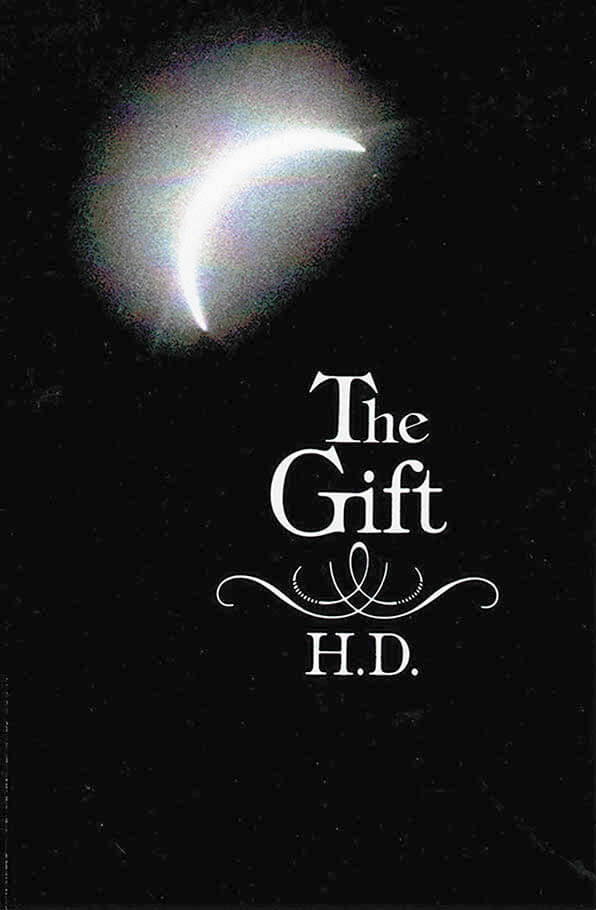
The Gift
The connections and interconnections of past and present––the realization that life is a whole continuously echoing back to the past and unfolding toward the future––were sources of the strength, renewal, and joy celebrated in H.D.’s Trilogy and, in a differing, but no less real way, in The Gift––her novelistic memoir of childhood. In recapturing her memories of being a very little girl in Bethlehem, Pennsylvania, and later on a country place outside Philadelphia, H.D. “let the story tell itself or the child tell it.” It is this voice or child’s-eye view that lends The Gift its special charm as H.D. recreates the ordinary and extraordinary occasions of her early youth, the nightmares and delights. A road-company presentation of Uncle Tom’s Cabin, Christmas Eve with its particular family ritual, a family outing, a disturbing accident––the happenings and incidents, perceptions and misconceptions with which a child’s life is crowded are the substance of this most winning book. As she did for the H.D. novel HERmione, H.D.’s daughter, Perdita Schaffner, provides a fine introduction.

Translation is a Mode = Translation is an Anti-neocolonial Mode
Don Mee Choi is the author of three books of poetry and hybrid essays, and an award-winning translator of contemporary Korean women’s poetry. In this pamphlet, Translation is a Mode=Translation is an Anti-neocolonial Mode, she explores translation and language in the context of US imperialism—through the eyes of a “foreigner;” a translator; a child in Timoka, the made-up city of Ingmar Bergman’s The Silence; a child from a neocolony.
This pamphlet is part of UDP’s 2020 Pamphlet Series: twenty commissioned essays on collective work, translation, performance, pedagogy, poetics, and small press publishing. Each offers a different approach to the pamphlet as a form of working in the present, an engagement at once sustained and ephemeral.
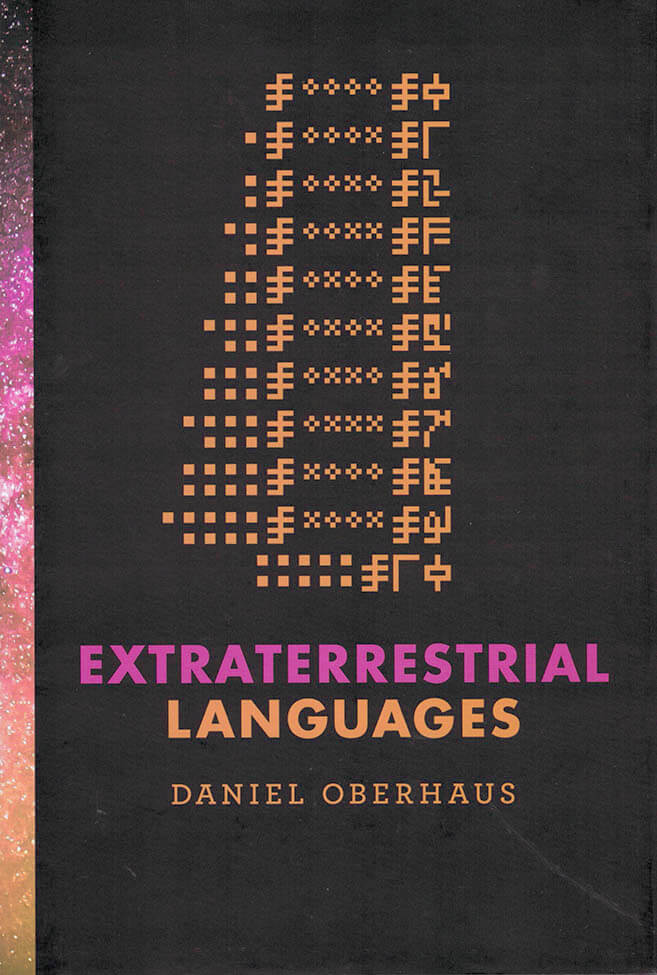
Extraterrestrial Languages
If we send a message into space, will extraterrestrial beings receive it? Will they understand?
The endlessly fascinating question of whether we are alone in the universe has always been accompanied by another, more complicated one: if there is extraterrestrial life, how would we communicate with it? In this book, Daniel Oberhaus leads readers on a quest for extraterrestrial communication. Exploring Earthlings' various attempts to reach out to non-Earthlings over the centuries, he poses some not entirely answerable questions: If we send a message into space, will extraterrestrial beings receive it? Will they understand? What languages will they (and we) speak? Is there not only a universal grammar (as Noam Chomsky has posited), but also a grammar of the universe?
Oberhaus describes, among other things, a late-nineteenth-century idea to communicate with Martians via Morse code and mirrors; the emergence in the twentieth century of SETI (the search for extraterrestrial intelligence), CETI (communication with extraterrestrial intelligence), and finally METI (messaging extraterrestrial intelligence); the one-way space voyage of Ella, an artificial intelligence agent that can play cards, tell fortunes, and recite poetry; and the launching of a theremin concert for aliens. He considers media used in attempts at extraterrestrial communication, from microwave systems to plaques on spacecrafts to formal logic, and discusses attempts to formulate a language for our message, including the Astraglossa and two generations of Lincos (lingua cosmica).
The chosen medium for interstellar communication reveals much about the technological sophistication of the civilization that sends it, Oberhaus observes, but even more interesting is the information embedded in the message itself. In Extraterrestrial Languages, he considers how philosophy, linguistics, mathematics, science, and art have informed the design or limited the effectiveness of our interstellar messaging.

Inflamed Invisible
A rich collection of essays tracing the relationship between art and sound.
In the 1970s David Toop became preoccupied with the possibility that music was no longer bounded by formalities of audience: the clapping, the booing, the short attention span, the demand for instant gratification. Considering sound and listening as foundational practices in themselves leads music into a thrilling new territory: stretched time, wilderness, video monitors, singing sculptures, weather, meditations, vibration and the interior resonance of objects, interspecies communications, instructional texts, silent actions, and performance art.
Toop sought to document the originality and unfamiliarity of this work from his perspective as a practitioner and writer. The challenge was to do so without being drawn back into the domain of music while still acknowledging the vitality and hybridity of twentieth-century musics as they moved toward art galleries, museums, and site-specificity. Toop focused on practitioners, whose stories are as compelling as the theoretical and abstract implications of their works.
Inflamed Invisible collects more than four decades of David Toop's essays, reviews, interviews, and experimental texts, drawing us into the company of artists and their concerns, not forgetting the quieter, unsung voices. The volume is an offering, an exploration of strata of sound that are the crossing points of sensory, intellectual, and philosophical preoccupations, layers through which objects, thoughts and air itself come alive as the inflamed invisible.

Jupiter: Andreas Sell ‘Life Performance’
Jupiter is the monograph of the artist Andreas Sell by the curator Joel Mu and the outcome of their collaboration. It includes a selection of Andreas’ work of the last fifteen years, an essay in five parts by Joel and a poem by Alice Heyward. Andreas’ work often coincides with his life story, composing both a material and immaterial narration. Joel shares biographical and autobiographical stories in his writing about Andreas’ work. The narratives intertwine.
Personal experiences, memories and relationships take shape with matter, images and words trying to make sense of the world—its social conditions and politics, other people and life itself.
Jupiter is about Andreas Sell’s ‘Life Performance’ as the title of the book suggests; it explores life performance from the constant position of a foreigner, from a viewpoint on the side. Andreas and Joel reflect on identities and challenge categorization; they seek for a more inclusive sense of belonging and defend the multiplicity of oneness. Jupiter also defies categorization; it is a monograph, but also a biography, an autobiography, a catalogue, an artist book, a diary, a collective work on one person’s work. — Text by Galini Noti
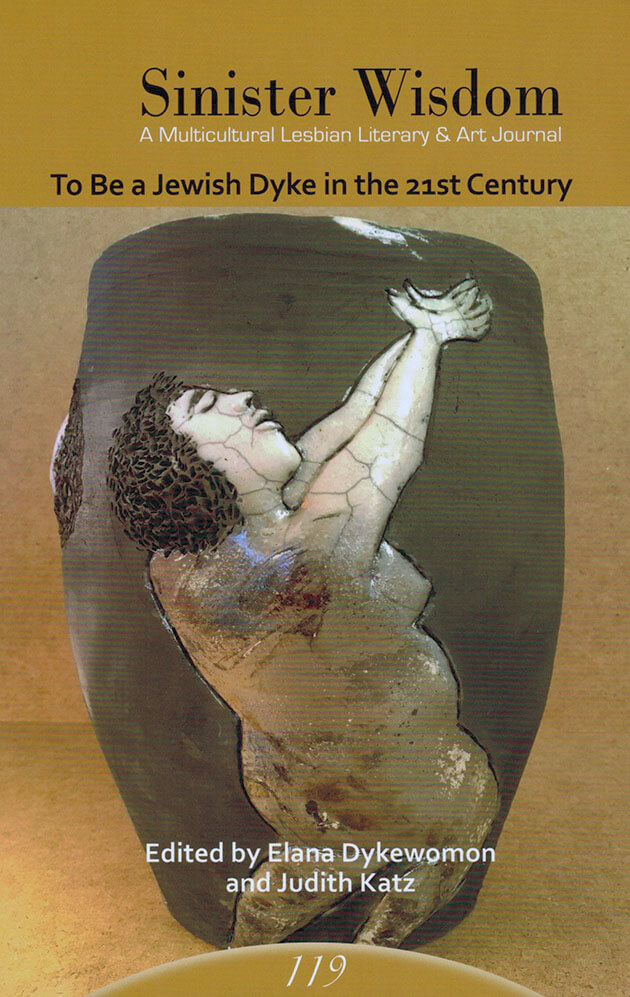
To Be a Jewish Dyke in the 21st Century
What are Jewish lesbians thinking about? Writing about? Making art about now, here in the first two decades of the 21st Century? Do we see ourselves as Jewish dykes? Jewish lesbians? Genderqueer Jews? How are we thinking about our Jewish lesbian communities and families, natal or invented? How have our relationships to the states of Israel and Palestine changed over time? Can we reconcile the contradictions between our faiths and our politics? Our gender and racial identities? How do we envision our futures and reimagine our pasts, especially in these fractious and dangerous times? One thing is certain. Our commitments to making trouble and speaking up are strong.
This issue of Sinister Wisdom: To Be a Jewish Dyke in the 21st Century, which takes its title from that life-giving stanza in Muriel Rukeyser’s epic poem “letter to the Front”, is a gathering of answers, challenges, and opinions directed at these and other questions.
Featuring work by
Yael Mishali
JEB (Joan E. Biren)
Terry Baum
Joan Larkin
Susan Sherman
Clare Kinberg
Irena Klepfisz
Nancy K Bereano
Penny Rosenwasser
Bonnie Morris
Jyl Lynn Felman
Marla Brettschneider
And more!
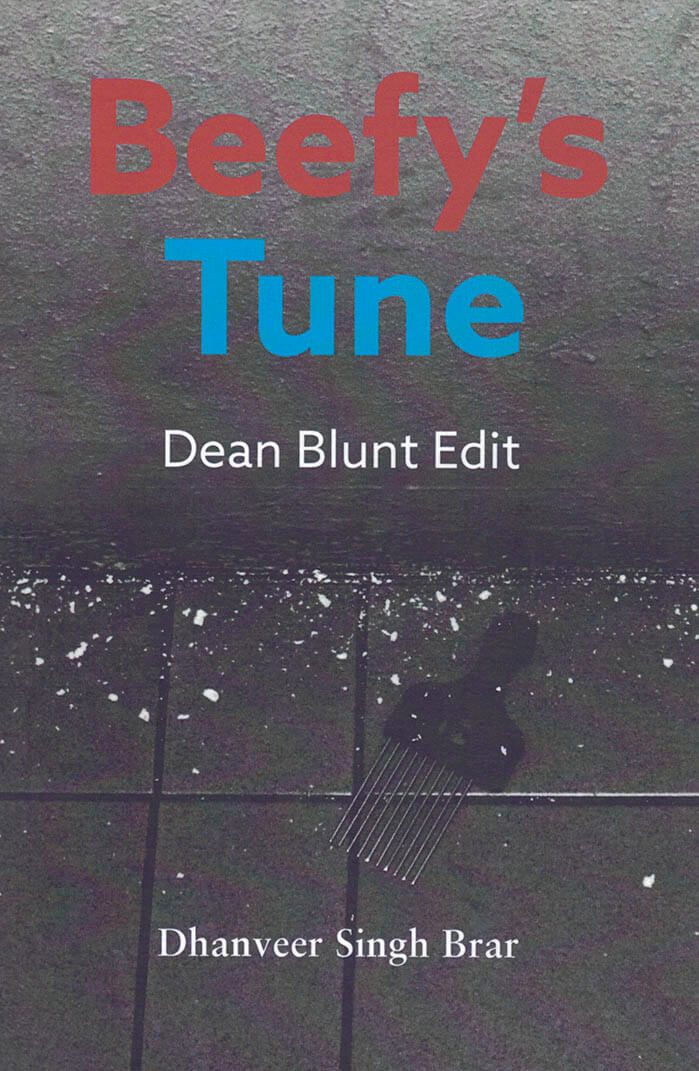
Beefy's Tune (Dean Blunt Edit)
Dean Blunt is one of the most important British artist of the current century because he fundamentally does not care about Britain. His importance makes it shocking that such little critical attention has been paid to his work. His indifference explains it.
Dhanveer Singh Brar’s ‘Beefy’s Tune (Dean Blunt Edit)’ looks to initiate a conversation that needs to be had about Dean Blunt, about Britain (through Blunt’s indifference to it), and about Blackness in Britain (through the depth and complexity of Blunt’s feeling for it). Using the 2016 album ‘BBF Hosted By DJ Escrow’ as a means of navigation, Brar hears Blunt in order to access the long contested dream of Britain’s disappearance that was conducted under the name of Black British Arts. Partial (in the sense of his relation to Blunt) and partial (in the sense of unfinished), ‘Beefy’s Tune (Dean Blunt Edit)’ see’s Dhanveer Singh Brar give the dream a grammar, if not a name.
Dhanveer Singh Brar is a theorist and scholar who teaches in the Department of Visual Cultures at Goldsmiths, University of London. His is a member of Le Mardi Gras Listening Collective and Lovers Discourse. Brar’s second book ‘Teklife, Ghettoville, Eski: The Sonic Ecologies of Black Music in the Early Twenty-First Century’ will be published by Goldsmiths Press/MIT Press in Spring 2021
"To encounter BBF Hosted by DJ Escrow through Dhanveer Brar’s ears is to see Babylon through his eyes, and to sense Britain—to uncover with 'accuracy, brutality and beauty' the complexities of its meaning—through the social music, social vision and social feel of those who refuse the Britishness that is withheld from them. Brar discerns Dean Blunt’s rightful place in a cultural field where critical discourse and sonic dream are fundaments of a dub university curriculum whose various approaches show the absolute necessity and generativity of stealth, flaw and the resistance to category. Blunt’s “love letter to the blackness of Hackney” deserves the most rigorous, gentle, erudite attention. Happily, Dhanveer Brar is here to provide it." – Fred Moten.

More-than-Human
Lucia Pietroiusti, Marina Otero Verzier and 1 more
The More-than-Human reader brings together texts that reflect on the state of post-anthropocentric thinking today, by writers from a wide range of disciplines. Focusing on the ecologies and technologies of climate injustice and inequalities, as well as the destructive structures lurking within anthropocentrism, More-than-Human proposes complex entanglements, frictions, and reparative attention across species and beings.
Thinking past the centrality of the human subject, the texts that compose this reader begin to imagine networks of ethics and responsibility emerging not from the ideologies of old, but from the messy and complex liveliness around and beneath us.
Rather than attempting to be a comprehensive compendium on the topic (which would be virtually impossible), More-than-Human provides a cross-section of the breadth and vitality of a literary, scientific, and conceptual milieu where multiple strands of work intersect even as they are frequently regarded as belonging to separate disciplinary discourses.
Contributors: Stacy Alaimo, Ramon Amaro, Karen Barad, Rosi Braidotti, Octavia Butler, Georges Canguilhem, Marisol de la Cadena, NASA History Department, Silvia Federici, Scott F. Gilbert, Édouard Glissant, Jack Halberstam, Donna Haraway, Myra J. Hird, Kristina Lyons, Patricia MacCormack, John T. Maher, Michael Marder, Timothy Mitchell, Reza Negarastani, Jussi Parikka, Elizabeth Povinelli, Paul B. Preciado, María Puig de la Bellacasa, Filipa Ramos, Isabelle Stengers, Elly R. Truitt, Anna L. Tsing, Eduardo Vivieros de Castro, Jason Wallin, Kathryn Yusoff and Joanna Zylinska.
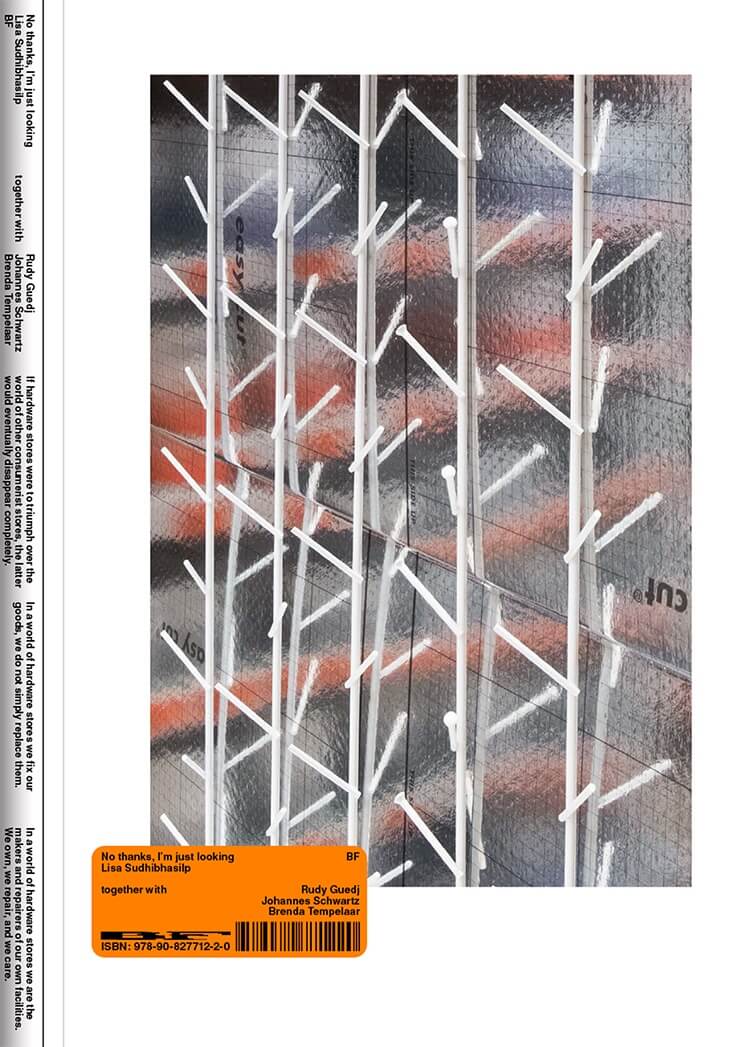
No thanks, I’m just looking
Born out of her fascination for shop displays, Lisa Sudhibhasilp imagined an exhibition in a hardware store. Improvising a series of sculptural interventions in situ, the artist played with existing display structures, proposing the hardware store as a place where the display of materiality can be contemplated like works of art in exhibition spaces. Photographer Johannes Schwartz documented the artist’s ephemeral installations and the existing fixtures and fittings, creating a portrait of the store. Accompanying the visual journey, a series of texts written by Sudhibhasilp, illustrated by Rudy Guedj, provides insight into her research through anecdotal stories and other miscellaneous facts on materials and exhibition design. Shifting between the form of the artist book and the exhibition catalogue “No thanks, I’m just looking” stands as the sole remaining document of the event.
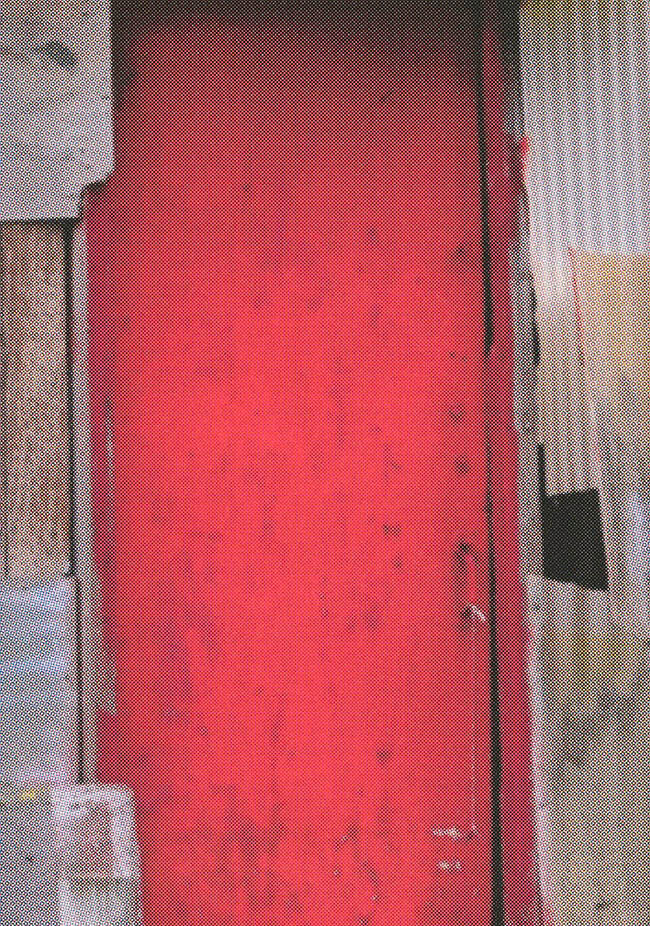
Bottle Joe
During their residency at Est-Nord-Est in Saint-Port-Joli, Quebec, Elvia Teotski and Jérémy Laffon stumble upon a small shed that seems inhabited but find no trace of its resident Bottle Joe. The artists start to investigate the building and create a series of sculptural yet functional wooden prostheses for its abandoned furniture. Through a drunk photographic journey and a series texts written from the perspective of the mysterious Joe, the publication keeps on zooming in and out of the building and its surrounding environment to account of the temporary monumentalisation of the place and its former inhabitant.

A Loose Thread of Red
The first book in a series of four explores a connection between images taken as part of a larger series in Japan over one summer and one winter. Each book has been lovingly hand-constructed.
The presence of self doubt is deeply felt when trying to compile a collection of photographs that have endured an endless process of revision and recompilation.
Scouring every inch of each image to find microscopic relations between subject, composition and colour until eventually something shifts and that 'everything in its right place' feeling soothes the throbbing head.
It's not an easy thing to articulate. It's a sort of subterranean relationship between each frame, as if a mysterious past or conspiracy that links everything together is identified, but still not understood.
It's as if the book always intended to exist and that you had been entrusted with the task of giving it life. (As you had possibly already done before?)
There's a certain term of phrase for someone who does the same thing repeatedly and expects different results.
So what is it to the person who stares at the same collection of images over and over and starts to see something different?
After such intense scrutiny nearly all memory associated with the photograph deteriorates. All that remains are hazy fragments of the original memories that seem like they're trying to tell you something but can't quite remember what it was.
And sandwiched around those memories are the new ideas that you've completely made up to talk yourself into sending this all off to the printers and moving on with your life.
Poetry has never been my strong suit, all attempts to metaphorically circumvent feeling or intention merely end up being interpreted as either the metaphor itself or something else entirely.
So perhaps we can sum this up very simply.
This is a book about red things.
Red has a way of implying a behind the scenes existence, a warning, distance, communication.
Or maybe, just overdue.
19 pages, 26.9 x 19 cm, softcover, Out of Office (Melbourne)
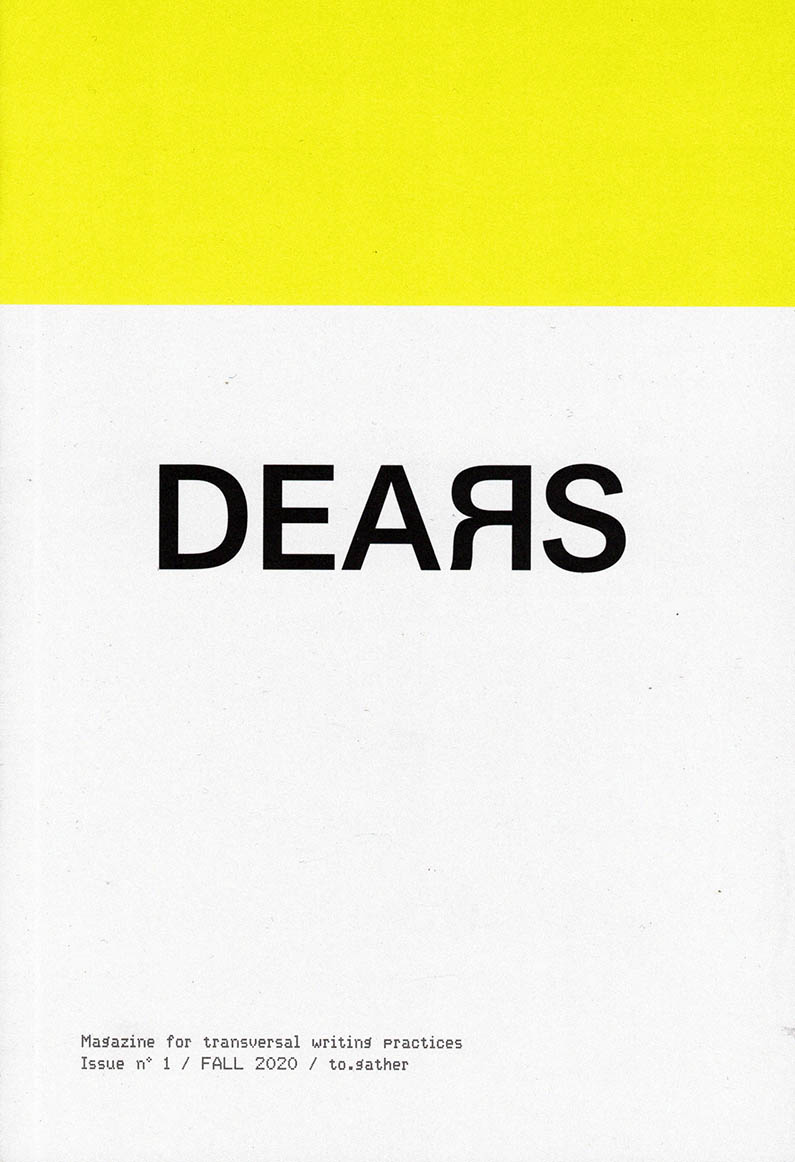
DEARS No. 1 TO.GATHER
Delphine Chapuis-Schmitz, Robert Steinberger and 1 more
DEARS Magazine on transversal writing, with texts by Season Butler, Crystal Z Campbell, Nicole Bachmann, Alessandro De Francesco, Benjamin Egger, Florinda Fusco, Gilles Furtwängler, Donna J. Haraway, Serafina Ndlovu, Rose Rand and Riikka Tauriainen.

The Little Black Book of Grisélidis Réal: Days and Nights of an Anarchist Whore
The Little Black Book of Grisélidis Réal is the portrait of a true humanist who made a career out of compassion. Hailed as a virtuoso writer and a "revolutionary whore," Grisélidis Réal (1929-2005) chanced into prostitution at thirty-one after an upper-class upbringing in Switzerland. Serving clients from all walks of life, Réal applied the anarcho-Marxist dictum "from each according to his abilities, to each according to his needs" to her profession, charging sliding-scale fees determined by her client's incomes and complexity of their sexual tastes.
Réal went on to become a militant champion of sexual freedom and prostitutes' rights. She has described prostitution as "an art, and a humanist science," noting that "the only authentic prostitution is that mastered by great technical artists...who practice this form of native craft with intelligence, respect, imagination, heart..."
This volume includes lengthy dialogues from 1979-1981 with Réal conducted by journalist and author Jean-Luc Henning, in which she eloquently discusses the theoretical implications of sex-positive whoring and relates her experiences both inside and outside the profession: from her lengthy love affair with the "Berber" to such "psychological" and "special" clients as the "moldy rhinoceros."
The "Little Black Book" that rounds out this book is drawn from the logs in which Réal kept track of her many clients, from "Pedro, hilarious fat Spaniard, devoted, simple, honest, fat peasant face, 70F" to "Pierre 8 (from Basel), blue eyes, fifties, slightly balding, cultivated, sweet-violent...licks my finger after I remove it from his anus...100-400F." It is a journal that not only chronicles Réal's working life, but offers a clinically direct, investigative sociological analysis of the sexual subcultures of her time.
Translated by Ariana Reines.

The Odd Years
Every Monday in 2017 and 2019, comedic performance artist Morgan Bassichis created a to-do list. THE ODD YEARS is a collection of those lists, which served both as a way to generate material for live performances and as a place to archive the logistical, emotional, and political business that just kept piling up throughout this two-year project. A record of routine and impossible tasks—some completed and others left unfinished—THE ODD YEARS is one response to the oddness of times in which intensified crisis becomes ordinary.
THE ODD YEARS is the fourth title in the Document Series, an interdisciplinary publishing initiative that highlights work by time-based artists in printed form.
Morgan Bassichis is a comedian and musician living in New York City. Morgan's performances include Nibbling the Hand that Feeds Me (Whitney Museum, New York 2019), Klezmer for Beginners (Abrons Arts Center, New York, 2019), More Protest Songs (Danspace Project, New York, 2018), and The Faggots & Their Friends Between Revolutions: The Musical (New Museum, New York, 2017).
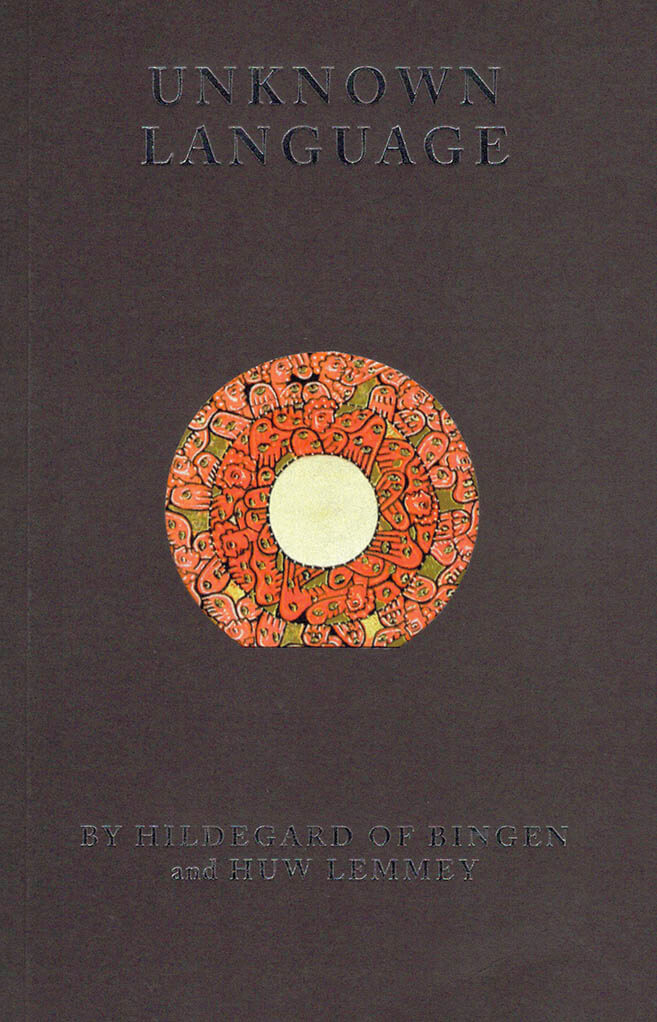
Unknown Language
Hildegard von Bingen, Huw Lemmey
Long, long before the Information Age ended, young Hildegard of Bingen finds beauty in the moral and spiritual ruins of her medieval world. In her forty-third year, she inscribes her cosmic visions into Scivias, an indescribably beautiful codex of writing and illuminations thought to be destroyed during the evacuation of Earth.
In a sea cave with cracked amethyst walls on Avaaz, Pinky Agarwalia discovers fragments of this visionary text containing hitherto unknown pathways to a lost vision of human co-existence with plants and non-humans - and the seeds of its rebirth on Avaaz.
Bursting with mythic quantum energy, Hildegard's vital linguistic potion viriditas, threaded throughout her communiqués, is a lush, verdant, renewable life-force. Her ecological message may be just the magic needed for rebirth on Avaaz. Hildegard's mystic toolkit for the future includes a cosmology, medicine, a morphology of crystals, recipes - and the symbols of a new language.
As Pinky Agarwalia traces the diagrams with her fingertip, she suddenly understands - a vision that appears without warning in her own mind - that she must first immerse these materials in water, a guarded substance. In the water, the molecules of the hidden language dissolve, freeze then reconfigure into new shapes, the crystalline language communicated not through sound but by feeling and light. Lingua Ignota, Hildegard's mysterious invented 'unknown language', arrives just in time for a world in flux, one whose coordinates are being recast.
Hildegard von Bingen (1098-1179), also known as Saint Hildegard and the Sibyl of the Rhine, was a German Benedictine abbess, writer, composer, philosopher, Christian mystic, visionary, and polymath. She is considered to be the founder of scientific natural history in Germany.
Huw Lemmey is a writer and publisher. He writes on culture, politics and sexuality, and is the author of the novels Chubz and Red Tory (Montez Press).

Glaring
Glaring: a sustained look of anger, an obvious fact, a situation of such brightness and intensity that vision is obscured. In his debut book of poems, Benjamin Krusling is concerned with reading domination and violence and entering their psychotic motion, the better to do otherwise. Through the thicket of anti-blackness, militarism, surveillance, impoverishment, and interpersonal abuse and violence, Glaring investigates the things that haunt daily life and make love difficult, possible, necessary.
Benjamin Krusling's Glaring is the winner of our 2019 Open Reading Period, and was selected by guest judge Lucy Ives.
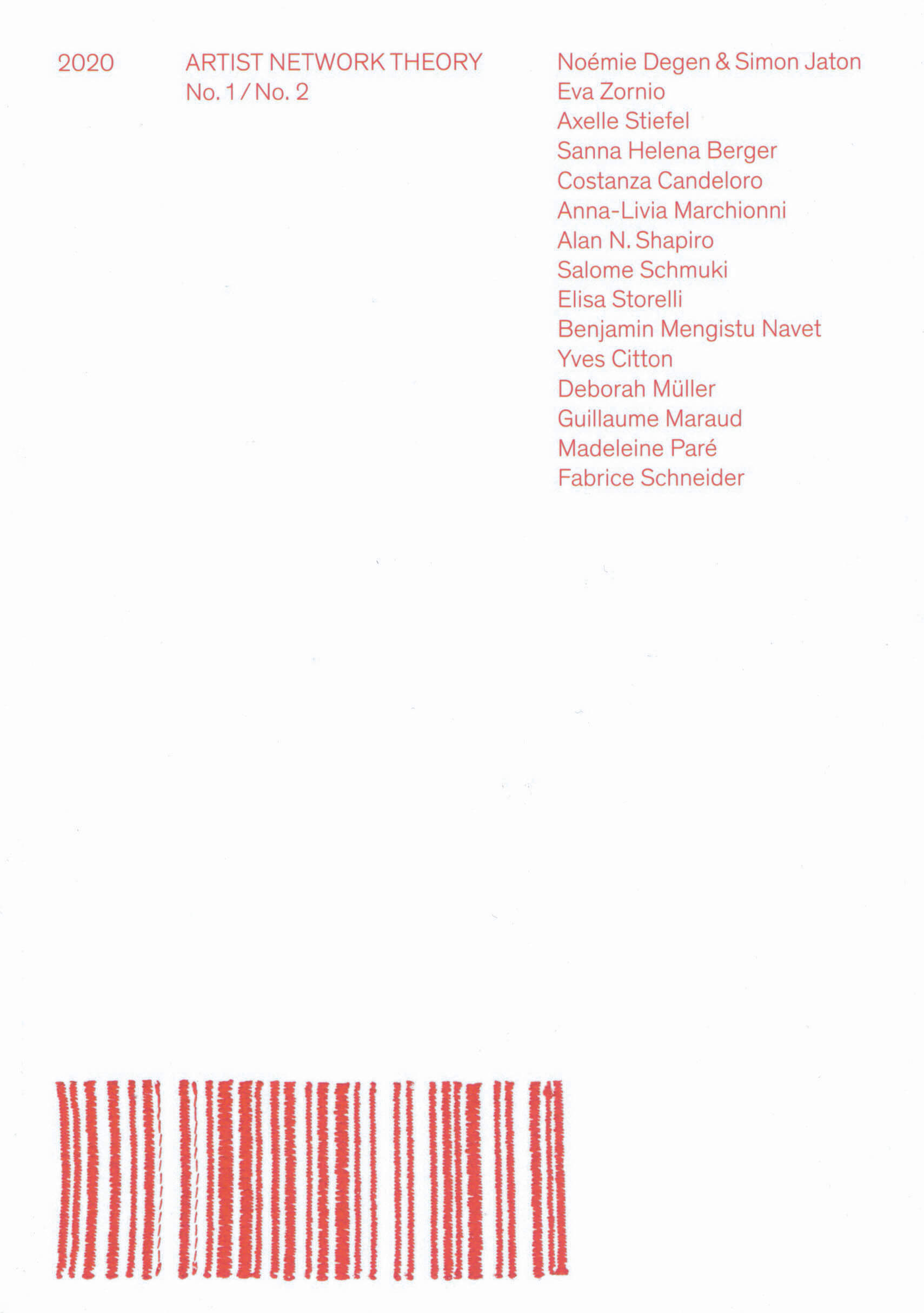
Artist Network Theory No.1/No.2
Sanna Helena Berger, Costanza Candeloro, Yves Citton, Noémie Degen & Simon Jaton, Guillaume Maraud, Anna-Livia Marchionni, Deborah Müller, Benjamin Mengistu Navet, Madeleine Paré, Salome Schmuki, Fabrice Schneider, Alan N. Shapiro, Axelle Stiefel, Elisa Storelli, Eva Zornio.
Trilingual Edition
FR/DE/EN
Editor Axelle Stiefel
Design Salome Schmuki
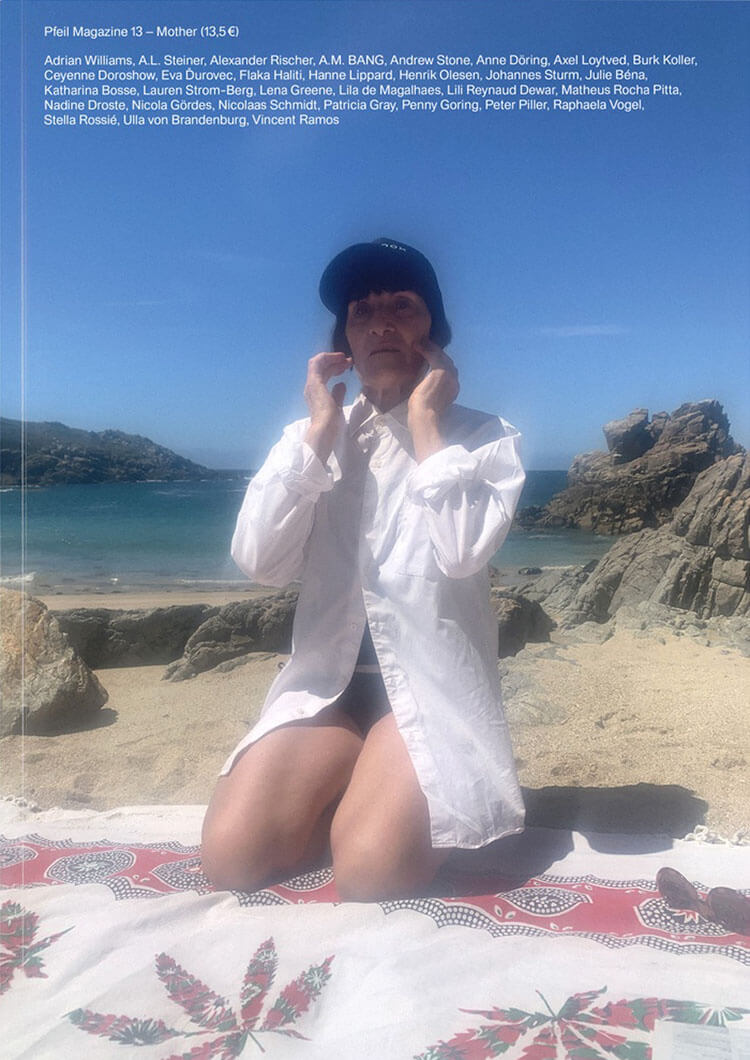
Pfeil Magazine #13 – Mother
The notion of a mother seems simple enough. But just one shy cut beneath the surface lies a multitude of facets, problems, questions, contradictions and wonders all connected to the idea of maternity. Biologically speaking, every person has a mother; perhaps it is the one fact we all have in common. Nevertheless this issue, dedicated to Mother, raises more questions than it is able to answer. Precisely because everyone appears to understand what a mother is, many crucial aspects of the topic are never questioned and are instead taken as a given. Is a mother defined by just having a child, or is it a child that defines the mother? Can we look at the mother without assuming womanhood? Can we untie the gendered attributes bound to the role of a mother? And what exactly are the notions of gender and sex that are connected to the common idea of motherhood? Where do they stem from? What kind of social, biological and economic pressure do mothers and potential mothers face?
In this issue, we explore alternative family structures and how responsibilities of parenting might be shared; prevailing working conditions for mothers in the arts; difficulties, challenges and prejudices mothers face in their professional lives, and what an ideal work environment might look like. Simultaneously, this issue deals with disappointments and unfulfilled expectations in the mother-child relationship, and again at that relationship in the social context. We picture the past and the present in the process of envisioning what maternity could look like in the future
Contributors
Adrian Williams, A.L. Steiner, Alexander Rischer, A.M. Bang, Andrew Stone, Anne Döring, Axel Loytved, Burk Koller, Ceyenne Doroshow, Eva Ďurovec, Flaka Haliti, Hanne Lippard, Henrik Olesen, Johannes Sturm, Julie Béna, Katharina Bosse, Lauren Strom-Berg, Lena Greene, Lila de Magalhaes, Lili Reynaud Dewar, Matheus Rocha Pitta, Nadine Droste, Nicola Gördes, Nicolaas Schmidt, Patricia Gray, Penny Goring, Peter Piller, Raphaela Vogel, Stella Rossié, Ulla von Brandenburg, Vincent Ramos.

Direct Into Chaos
Aleen Solari’s work is shaped profoundly by insights into various subcultures. These insights are partly drawn from her own experiences, partly borrowed from members of certain scenes who she invites to be part of her work. Her sculptural practice moves in and out of life within these groups, and is full of codes and quotations from antifa members, football hooligans, bored youth clubs or those embedded in neonazi networks.
Direct Into Chaos is a book that dives deep into these worlds, shape-shifting between fiction, documentation and artwork. In ghost written texts, Solari fictionalises her own artistic biography, morphing interviews with football hooligans who had their phones tapped by the police, into a dream world where they receive generous compensation for years lived under surveillance.
In this publication – in a chaotic, dreamlike state of mind – fiction and documentation, art and activism meld into something new.
Aleen Solari is an artist who lives in Hamburg, Germany
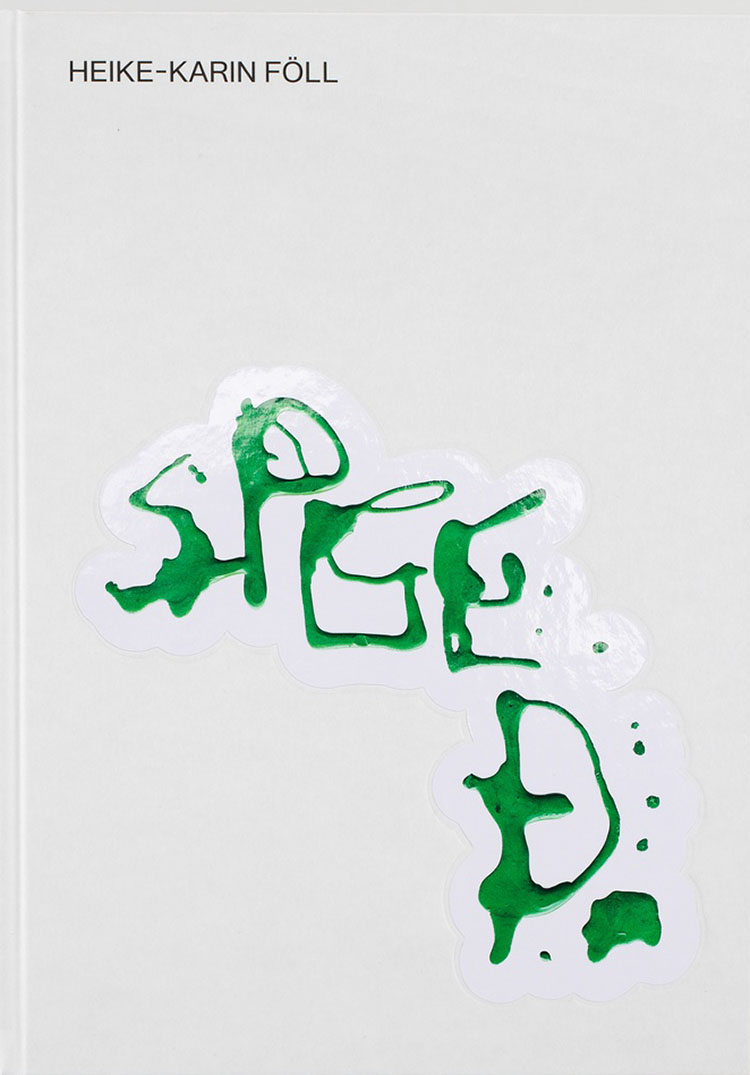
SPEED
Heike-Karin Föll’s foundational collection of works on paper refuses, in its totality, to be pinned down. SPEED exists in a sequence of autonomy, embracing simultaneity and resisting typical chronology or logic. A resource library for Foll’s more well known painted works, each page also stands on its own. The “writing” and “rewriting” of these pages is a rejection by the artist to rest on what has already been accomplished, and insists on constantly renewing modes of expression amidst the routine and expected.
SPEED takes the form of visual index, a micro structure of narrative, through the space of the page. Blank spaces (components of in-betweens and not-yets), textual elements, found images, and abstract icons are assembled from a daily stream of computational information and graphics to bring us into the temporal now. The pages slip from medium to medium, relying on short forms and small units as the bases for recontextualisation and variation. Montez Press is honoured to be able to offer an opening for these vast and untamable works by Heike-Karin Föll.
Heike-Karin Föll is painter who is currently based in Berlin. She works with the materiality and mechanics of painting and language, treating textuality as equally a vehicle of content, a visual motif and a material form.

Chubz: The Demonization of my Working Arse
Andy ‘Chubz’ Wilson is just another NEET on the street, spending his summer days sucking dick and chilling in the park, one hand on his touchscreen, the other down his pants. That is, until he meets charming left-wing journalist and cute crypto-twink Owen whilst trawling Grindr for sex. But what starts as a quick, breathless hookup ends up changing Chubz — and London — forever. Whilst Owen battles poppers-mad PM Nigel ‘Nige’ Farage, our cock-hungry comrade wages his own 'ass war', and is left wondering: just what exactly is it he’s fighting for? Socialism? Barbarism? Or just cheap kicks?
YOUTH RAGE! YOUTH VIOLENCE! YOUTH ORGASMS! FEAR OF A GAY UNDERCLASS – ARMED – DANGEROUS - SICK FUCKS.

BEZNA
Irina Gheorghe, Florin Fleuras and 1 more
Bezna is darkly glowing dead thinking, cosmic pessimism, hairy autonomy, inner reptilians, limbo sighs, horrendous pink volumes, underground nematodes, happy dismemberment, haunting prehumanism, compassion crises, glowing horror, sinister moods, aesthetic autophagia, postspectacle shelters, eternal stillness, future plague, decomposing knowledge, ouroboric moves, idiot nonknowing, shadow bodies, netherworld excavations, imperceptible evil, hyperbolic specters and news from Cioran.
Bezna's first issues were edited by Florin Flueras, Veda Popovici and Arnold Schlachter, the last ones by Florin Flueras, Irina Gheorghe and mainly by Alina Popa, in the memory of which this anthology is published.
'Bezna' in Romanian means consistent darkness + diffuse fear
Edited by: Alina Popa, Florin Flueras, Irina Gheorghe, Veda Popovici, Arnold Șlahter, Claudiu Cobilanschi
Contributions by Roi Alter, Aparat Security, Aulos, Brynjar Abel Bandlien, Emil Cioran, Ciumafaiu, ClaudiuCobilanschi, Octavian-LiviuDiaconeasa, Valentina Desideri, Bogdan Draganescu, Ion Dumitrescu, Florin Flueraş, Irina Gheorghe, Amy Ireland, Sarah Jones, Anastasia Jurescu, Kroot Juurak, Deanna Khamis, Mihai Lukacs, Nicola Masciandaro, G.A. Neagu, Dorothee Neumann, Cosima Opartan, Paradis Garaj, Alina Popa, Veda Popovici, Arnold Slahter, Taulipang Indians of Guyana, The Bureau of Melodramatic Research, The Presidential Candidate, Eugene Thacker, Stefan Tiron, Dylan Trigg, Tea Tupajic, Akseli Virtanen, Ben Woodard.